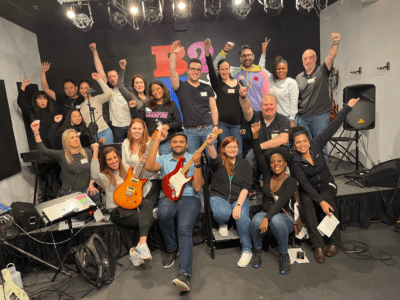Learning how to motivate teams after layoffs is crucial for leaders who want to maintain productivity and boost morale during challenging transitions.
Whether you’re downsizing due to economic pressures or restructuring to streamline operations, it’s essential to maintain company culture and boost employee morale throughout the process.
During these times, HR teams face challenges such as employee anxiety, trust issues, and shifting group dynamics.
This article will highlight expert tips for maintaining employee engagement, morale, and workplace culture after layoffs, restructuring, or M&A (mergers and acquisitions).
The Connection Between Team Building & Corporate Transitions
In our latest episode, The Inside Scoop on Team Building Events, we spoke with Kevin Pertusiello about the ins and outs of team building events, how and why they work, and the impact they can have on company culture.
During our discussion, Pertusiello noted that team building can serve as an effective bridge between two corporate cultures during a merger. He said:
“There may be times when different groups are coming together because they really don’t know each other, and that has sometimes fostered some issues when it comes to trust. So it ends up being our job—whether the client knows it or not—to get people to the same table and be able to see each other for who they are.”
TeamBonding founder David Goldstein also emphasizes the importance of employee engagement after layoffs or restructuring:
“The period immediately following layoffs or company restructuring is critical for maintaining retention and morale. Companies that actively work to rebuild trust and engagement can reduce voluntary turnover.”
How Different Corporate Transitions Impact Employees
Before we dive into solutions, it’s essential to understand the impact that different corporate transitional periods—think layoffs, organizational restructuring, or an M&A—have on employees.
Impact of Mergers and Acquisitions
An M&A often completely shifts a company’s culture and employee sentiment, which raises potential difficulties and challenges leaders need to overcome.
Many employees will be upset at the idea of a merger—they’re likely to be worried about potential layoffs, changes in culture, and more. This may lead to a toxic work environment if these concerns are left unaddressed.
With two completely different companies attempting organizational integration, you’re likely to change standard operating procedures, leadership styles, and organizational goals. There’s also often a change in management that may upset team members.
Cultural integration is crucial
Cultural integration refers to integrating separate business cultures during a merger to ensure a smooth transition. This is essential because there is often a wide gap between the two cultures during a merger.
Both of them can be healthy cultures, but there is still going to be a gap. Addressing those differences is key to success. Pertusiello noted this during our podcast, saying:
“Now and again, we’ll get called in as TeamBonding to connect a team that has had some kind of merger or a combination of departments–and it may be two groups of people that really don’t trust each other due to a lack of knowledge.”
There are also numerous benefits that come with well-executed organizational integration. For example:
- Improved communication
- Stronger employee trust
- Better engagement
- Enhanced creativity
- Healthier company culture
Impact of layoffs and restructuring on employees
It’s important to think about the impact of layoffs on surviving employees. A restructuring event can completely shift a company’s culture and change employee sentiment, and this raises potential challenges that leaders must address.
Remaining employees might experience:
- Survivor’s guilt about keeping their jobs while their work friends lost theirs
- Anxiety about ongoing job stability
- Increased workloads as they take on responsibilities from departed colleagues
- Uncertainty about new management, reporting structures, and team dynamics
- Decreased trust in leadership and organizational stability
All of these emotions can interfere with psychological safety if not addressed, which is why learning how to motivate teams after layoffs is so crucial for recovery.
Team building is essential
Team building activities after layoffs and restructuring are invaluable for helping build bonds and strengthen teams.
When your employees engage in team building activities, they get to see each other in a different light and connect with people outside of their usual workplace setting. They’re a great way for everyone to connect and find a greater sense of community.
Team building activities help:
- Boost team performance
- Increase morale
- Spark innovation and creativity
- Build trust between team members
- Cultivate a positive company culture
- Connect teams across all departments and levels
- Enhance employee engagement
- Increase retention and job satisfaction
“Team building isn’t just a nice-to-have in these situations, it’s an essential investment in protecting your teams,” adds Goldstein.

5 Tips to Maintain Organizational Integrity
Now that we’ve discussed why it’s essential to learn how to motivate teams after layoffs and why organizational integration is so beneficial, let’s dig into some tips to maintain team morale and motivation during transitional periods.
1. Encourage Open Communication
Open communication plays a big role here—employees want transparency when going through big organizational changes. They want to ask questions, get more information, and alleviate their fears and concerns.
Communication helps build trust in the workplace, which helps ease employee concerns during a merger. If employees trust their company and their leaders, they’re typically more willing to “go with the flow” and give the merger a fair shot.
To boost employee engagement after layoffs and maintain open communication channels, your leaders can:
- Hold regular meetings where leaders share updates and answer employee questions
- Establish anonymous feedback channels where concerns can be raised safely
- Schedule one-on-one check-ins to provide personalized support
- Share their vision for the company’s future and the role each employee plays in it
The bottom line is to make sure everyone can speak and have their voice heard. Leaders should leave their doors open to all employees, ensuring anyone can have a direct conversation with them.
This allows employees to have their concerns heard and addressed quickly, preventing any build-up of negativity or fear.
2. Focus On Employee Well-Being
Another big tip for how to motivate teams after layoffs is to focus on employee well-being. One of the biggest concerns employees have around a merger is that things like workload, work-life balance, and employee well-being will be negatively impacted.
Focusing on well-being while you’re integrating teams after a merger or transitional period can help address those concerns. It also helps boost employee happiness in general, which translates into better and more efficient work.
There are many things leaders can do to prioritize well-being:
- Offer wellness programs and mental health resources
- Provide flexible work hours to help with work-life balance
- Take employee concerns about workload into account
- Maintain realistic expectations for productivity during the transition
The key here is to listen to your employees. No one knows how they are feeling better than themselves, so listen to them and empathize. Follow their lead and act on their suggestions.

3. Emphasize Employee Engagement
Employee engagement also plays an important role in maintaining organizational integrity during significant transitions. Engaged employees are happier, more productive, and more willing to work through the challenges associated with a merger.
There are many ways to emphasize engagement:
- Engagement activities can help shape a positive workplace
- Gamification can foster engagement and employee development
- Rewarding and recognizing employees for their hard work and flexibility can boost morale
The most important part is to ensure that your employees are being engaged during the merger. It’s easy to get caught up in the big picture and the bottom line, but you need to take the time to focus on employees as well.
4. Lead by Example
Employees tend to mirror their managers; if you have a bad attitude, your employees probably will too. That means one of the best ways to navigate cultural integration is to lead by example. Pertusiello emphasized this point heavily when he said:
“I can tell right away how a company is doing by watching what the management-level people do when they come to these events. I can’t count how many events we’ve hosted where the managers or leadership say things like:
“‘We’re not going to play. We want them to play, we’re just going to take pictures and go.’
“When this comes up, I typically say, ‘No, you’re not. You’re staying, you’re playing, and you’re going to have a good time. They need to get to know you as much as you need to get to know them.’”
During company restructuring, leaders need to:
- Lead with kindness, transparency, and empathy
- Embody the company’s values
- Demonstrate resilience during challenging times
- Be examples of adaptability and growth
- Show authenticity and vulnerability while maintaining confidence
If you’re setting a good example of resilience and optimism, your employees are more likely to follow suit and do the same.
5. Foster Collaboration
Collaboration is also incredibly important when figuring out how to motivate teams after layoffs and mergers. With restructured departments or two different company cultures, it’s one of the best ways to bring people together and form lasting connections.
Encouraging collaboration—whether that be within existing teams, cross-departmental collaborations, or for new teams/team members—helps employees learn more about each other, build bonds, and ultimately ensure a smoother organizational integration.
This can be as simple as having two different teams come together to plan a party, or it can be as complicated as having them work together on an incredibly important project across departments.
Team building activities can also be a good option here. Having employees engage with each other through team building helps develop relationships that foster understanding, communication, and collaboration.
Regardless, the main focus is that you’re bringing people together and encouraging collaboration. That goes a long way in helping your cultures integrate smoothly during a merger.
Team Building Ideas After Layoffs or Restructuring
Relying on team building activities after layoffs or restructuring can help with managing work culture and organizational integration. If this is something you’d like to try, we’ve got you covered.
Here are some effective ways you can build bonds and strengthen your teams after a transitional period.
Breaking Barriers Program
Breaking Barriers is a popular team bonding event that helps employees overcome barriers and fears while shifting to focus on their goals, all while bringing people together and building lasting bonds.
Bridging the Divide Event
Another event well suited for a merger is Bridging the Divide. This event puts a focus on the idea that all organizations and departments are vital to the company’s success. This can elevate employee connection, break barriers, and bridge the divide between teams.
Build Emotional Intelligence
Emotional intelligence is also key during a merger, which makes Emotional Intelligence for Teams a great resource. As the name suggests, this event is also about prioritizing emotional intelligence, which helps your teams more effectively integrate.
Corporate Social Responsibility
To wrap things up, charity team building and corporate social responsibility (CSR) activities are also effective options. What better way to bond with new coworkers than by doing good in the community?
Charitable team building events can be effective ways to bond even the most disjointed teams. Pertusiello talked about how effective these events can be during our discussion, noting:
“The fact that you’re able to get your team together while being able to help a local organization of kids, soldiers, or people who are dealing with illness. The fact that you’re able to help your team and others at the same time within one event—it’s a home run every time.”
Ensure a Smooth Transition After Big Company Changes
Learning how to motivate your team after layoffs can be challenging, but you can ensure a smooth transition by empowering employees and bringing them together.
By prioritizing open communication, employee well-being, engagement, collaboration, and strong leaders who lead by example, you can effectively integrate cultures and help set up an M&A or restructuring process for success.
While that may seem difficult, team building events can be extremely effective at getting a team in a positive and trusting headspace after a merger while also bringing employees together.
At TeamBonding, we put a fun spin on team building events and focus on takeaways that can help you and your team navigate organizational changes. Get in touch with us to help make your company restructuring as positive and successful as possible.
















